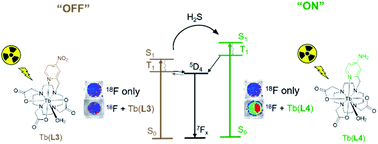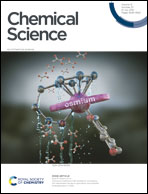Accessing lanthanide-based, in situ illuminated optical turn-on probes by modulation of the antenna triplet state energy†
Abstract
Luminescent lanthanides possess ideal properties for biological imaging, including long luminescent lifetimes and emission within the optical window. Here, we report a novel approach to responsive luminescent Tb(III) probes that involves direct modulation of the antenna excited triplet state energy. If the triplet energy lies too close to the 5D4 Tb(III) excited state (20 500 cm−1), energy transfer to 5D4 competes with back energy transfer processes and limits lanthanide-based emission. To validate this approach, a series of pyridyl-functionalized, macrocyclic lanthanide complexes were designed, and the corresponding lowest energy triplet states were calculated using density functional theory (DFT). Subsequently, three novel constructs L3 (nitro-pyridyl), L4 (amino-pyridyl) and L5 (fluoro-pyridyl) were synthesized. Photophysical characterization of the corresponding Gd(III) complexes revealed antenna triplet energies between 25 800 and 30 400 cm−1 and a 500-fold increase in quantum yield upon conversion of Tb(L3) to Tb(L4) using the biologically relevant analyte H2S. The corresponding turn-on reaction can be monitored using conventional, small-animal optical imaging equipment in presence of a Cherenkov radiation emitting isotope as an in situ excitation source, demonstrating that antenna triplet state energy modulation represents a viable approach to biocompatible, Tb-based optical turn-on probes.



 Please wait while we load your content...
Please wait while we load your content...